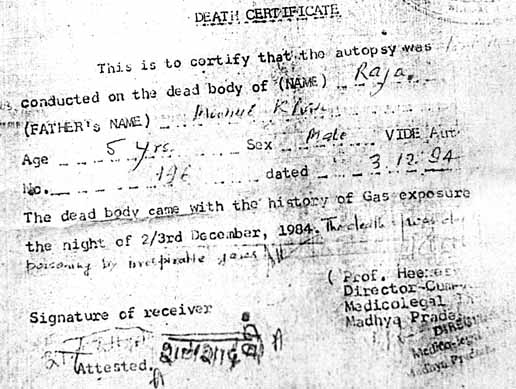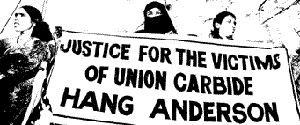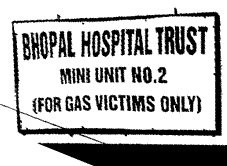| On the night of 2nd - 3rd December
1984,40 tones of methyl iso cyanate and other lethal gases leaked
from Union Carbides Bhopal Factory. This remains the worst industrial
accident ever. It is estimated that 8,000 people died in the immediate
aftermath, that the death toll to date is 16,000 and that 500,000
people's health has been adversely effected. The "gas effected"
people of Bhopal still fight for justice and compensation.
{top}
Since 1984 the Western World seems either
to have forgotten Bhopal, or the name has become an abstract symbol
in the same way that Dunblane and Lockerbie have. In India ecological
disasters are often labelled"mini-Bhopals" or "the
next Bhopal". In Bhopal the survivors harbour anger and resentment
mainly for the way in which they have been treated by their government
and Union Carbide since the disaster as well as for the disaster
itself.

The gas spread through the slums and poor
suburbs, which are clustered around the factory. If it had made
it across the vast lakes to New Bhopal and the affluent end of town
things may have turned out differently however, many unaffected
people now think that the survivors should stop moaning and move
on. As it stands, most of the survivors have received about £350
(Rs 25,000) in compensation from Union Carbide, about half of which
has been deducted to repay earlier government relief. This leaves
many of the survivors badly in debt having sold their homes and
possessions to cover medical expenses.
{top}
The medical legacy of the disaster continues.
A medical survey conducted between 1987 and 1991 showed that there
was a threefold increase in the number of people with respiratory
symptoms. As well as asthma, recurrent chest infections and fibrosis
of the lungs the prevalence of pulmonary chest infection is more
than three times the national average. There is a host of other
lasting medical and psychiatric problems associated with surviving
the disaster including eye damage, joint pain and post-traumatic
stress disorder.
{top}
The full extent of these symptoms is not
known since medical research was terminated in 1994. These problems
are compounded because government doctors have never kept medical
records on people seeking help. In fact they have been seriously
criticised for using inappropriate drugs to provide short-term relief
and ignoring long-term treatment of chronic illnesses. The government
has built several new hospitals. The largest (the Kamala Nehru hospital)
is still not completed and despite being started in 1987 has not
treated a single gas victim. During it's construction the cost of
the Kamala Nehru hospital has tripled and survivors groups have
made accusations of profiteering and corruption.

Stories of corruption within the government
hospital system are common and usually concern doctors who refuse
to see patients admitted unless they turn up for their private clinics.
One woman said that she had to pay a large bribe to a doctor to
see her father after he had lain comatose in a hospital bed for
two weeks without being examined. Many families have had to sell
everything that they own in order meet large medical expenses.
{top}
It was in response to the government's
appallingly chaotic medical response that the Sambhavna Trust clinic
was opened in 1996. It offers a choice of conventional or ayurvedic
treatment as well as massage and yoga therapies. Unlike the government
hospitals keep detailed records on each patient and constantly evaluate
the effectiveness of all the treatments they offer. The Trust raises
money from private donation and refuses corporate donations.
{top}
Union Carbide's response to the disaster
was denial. After failing to raise the alarm once the MIC leak had
been detected, Union Carbide then declared that the gas was "like
tear gas" and that "you apply water [to the eyes] and
you get relief". A few days later, even after the death toll
topped 8,000 people, a Union Carbide representative was quoted as
saying that the gas was "nothing more than a potent tear gas".
Doctors associated with Union Carbide pump out misinformation, attempting
to hide any evidence that the effects of exposure to the gas were
permanent.
{top}
In the years that followed Union Carbide
did everything they could to play down what had happened and to
escape criminal charges and payment of compensation. The Indian
government, on behalf of the victims, filed a suit for 3 billion
US dollars but eventual settled for only 470 million US dollars.
In return criminal charges against the corporation would be dropped
and the Indian government would defend any other suits filed against
Union Carbide. With the amount of people involved this level of
compensation is less than the Indian government standard for railway
accidents.

On appeal in 1991 the Supreme Court (the
highest court in India) ruled that the amount of compensation would
stand but in addition Union Carbide must build a 500-bed hospital.
It also revoked the corporation's immunity from prosecution and
charges of culpable homicide were reinstated. In 1992 after the
failure of Union Carbide's representatives, including Warren Anderson,
to respond to numerous summonses, Bhopal District Court froze the
parent companies shares in the Indian subsidiary.
{top}
The response of Union Carbide was to create
the Bhopal Hospital Trust (BHT) to build the hospital. Despite a
Bhopal Court ruling that money for the hospital should come from
Union Carbide itself the Supreme Court allowed the BHT to receive
the money from the sale of the subsidiary shares. Union Carbide
itself only donated one thousand pounds to initiate the BHT and
now free from punitive measures has continued to ignore summonses.
{top}
The BHT's health care plans have been seriously
criticised by several medical bodies and survivors groups have questioned
the sense of building another hospital in a city that probably has
more hospital beds per head of population than any other city in
the world. These survivors groups are also concerned that a company
previously engaged in chemical and biological warfare research should
be permitted to run a ten-bed research unit in the hospital, especially
considering that there is no undertaking to release findings. While
the hospital was under construction the building site was raided
by labour officials who found that child labourers, as young as
nine years old, were being employed.
{top}
Today the decaying the Union Carbide factory
remains abandoned and decaying, even the slums that were upwind
from the factory on the night of the disaster are now being effected.
Toxic material, released as the factory decays, has entered the
ground water use by the slums for washing, cooking and drinking.
The site in now owned by the state government who have recently
been searching for a way to redevelop the area. One suggestion that
surfaced and was quickly condemned by activists was to build a theme
park to attract tourists.
{top}
Another disturbing legacy of the Bhopal
disaster has appeared recently. When DuPont were negotiating with
the Indian government over plans to build a nylon factory in Goa,
they insisted that the parent company would not be liable for any
industrial disaster that may befall the Indian subsidiary.
|
